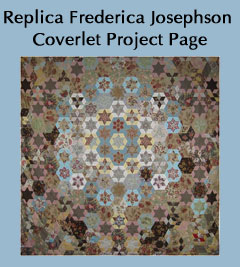1930s Quilts Event Report
 On
the 27th February 2010 at the Powerhouse Museum, Jennie Burton gave the
Quilt Study Group of NSW members and friends a 30 minute talk about
1930s quilts. She brought along some 1930s quilts, quilt tops and feed
sacks from her collection for us to see. She told us that she is drawn
to these quilts for their colourful scrappiness and put the making of
these quilts into historical perspective, referring to the influence of
the depression years of the 1930s, changes in fabric dyes, the mass
production of bed coverings and then the revival of quilt making between
the wars.
On
the 27th February 2010 at the Powerhouse Museum, Jennie Burton gave the
Quilt Study Group of NSW members and friends a 30 minute talk about
1930s quilts. She brought along some 1930s quilts, quilt tops and feed
sacks from her collection for us to see. She told us that she is drawn
to these quilts for their colourful scrappiness and put the making of
these quilts into historical perspective, referring to the influence of
the depression years of the 1930s, changes in fabric dyes, the mass
production of bed coverings and then the revival of quilt making between
the wars.During the Depre
 ssion
the number of advertisements, patterns and articles about quilts in
newspapers increased so that many women had scrapbooks containing
planned quilts (not dissimilar to us now). Popular patterns included the
Dresden Plate, Butterfly, Grandmother’s Flower Garden, Sunbonnet Sue,
and Double Wedding Ring because they all involved using up fabric
scraps. “Use up, wear out, make do or do without” was the motto for
these women. Quilting in the 1930s also provided a way for some to make
money by designing quilt patterns, making and selling quilts and quilt
kits and by winning prizes at quilt shows. Quilts were also a softer
side of the Great Depression and the importance of sewing and quilting
bees took the quilters’ minds off their troubles.
ssion
the number of advertisements, patterns and articles about quilts in
newspapers increased so that many women had scrapbooks containing
planned quilts (not dissimilar to us now). Popular patterns included the
Dresden Plate, Butterfly, Grandmother’s Flower Garden, Sunbonnet Sue,
and Double Wedding Ring because they all involved using up fabric
scraps. “Use up, wear out, make do or do without” was the motto for
these women. Quilting in the 1930s also provided a way for some to make
money by designing quilt patterns, making and selling quilts and quilt
kits and by winning prizes at quilt shows. Quilts were also a softer
side of the Great Depression and the importance of sewing and quilting
bees took the quilters’ minds off their troubles. The feed sacks, which provided cheap fabric for the 1930s quilts, were originally made from plain calico and were hand sewn by the farmers with hand written labels. Later they were sewn by machine and had pre-printed labels that had to be soaked off in order to use them. The feed sack bag and sack manufacturers then came up with the idea of using patterned fabrics thus leading to their use in making curtains, dresses, quilts and even underwear. The finer grades of feed sacks were used for holding sugar or flour, the coarser ones for corn or chicken feed. Now they are discovering whole attics full of feed sacks which are coming onto the market.

Jennie then showed us some American feed sacks which prompted Annette Gero to show us her Australian feed sack. Among the many wonderful quilts from Jennie’s collection we saw one unusual quilt with black baskets, another with a yellow background and a vibrant ‘Trip Around the World’ quilt with such perfectly matching fabric that she believes it could only have been from a quilt kit.





No comments:
Post a Comment